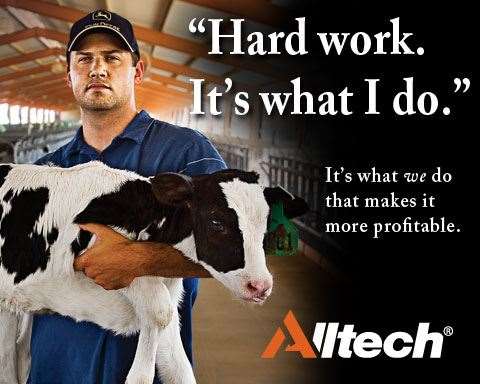It’s not a stretch to say the time may come when feed mills will have a difficult time sourcing corn, soybean meal, cottonseed, urea, distiller’s grains, blood meal, and/or fishmeal. With daily news articles focusing on how the agricultural industry can produce enough food to feed an additional 3 billion people by 2050, continue to meet the renewable fuels mandate, and provide safe, quality products for a more engaged consumer audience, the task for locating a secure source of protein may soon prove to be a daunting undertaking for the livestock industry.
With these stakes at hand, many companies are starting to look beyond available protein sources on land, but to the sea. Algae, a buzzword in the biofuel industry five years ago, is the new game changer in the animal feed industry. One of nature’s most important and unique organisms, algae contributes to the air we breathe, producing nearly 50 percent of the oxygen in the atmosphere and directly supporting the ocean life, therefore playing a major role in global productivity.
While most of the attention on algae has focused primarily on it being a source for biofuel, the microalgae contain large quantities of high quality eicosapentaenoic acid (EPA) and (docosahexaenoic acid) DHA that can bring additional nutritional improvements to feeds and food. Currently, the most common sources for DHA or “good fat” are fish meal and fish oil. However, these products can often be inconsistent, unsustainable, unavailable, poor quality and unsafe.
There are an estimated 800,000 species of algae that range from single-celled microorganisms to multi-celled organisms, such as the 200-foot long giant kelp. Algae produces carbohydrates, oils, protein, vitamins, pigments and organic materials.  Since they are aquatic, algae grow much faster than land plants as they do not have to expend energy growing roots and support structures like trunks, leaves and stems. Without the need for support, algae can triple or quadruple their biomass every day. While land plants only grow in one direction, algae can grow in all directions. This rapid growth means that one acre of algae can produce the same amount of protein in a year as 21 acres of soybeans or 49 acres of corn.
Since they are aquatic, algae grow much faster than land plants as they do not have to expend energy growing roots and support structures like trunks, leaves and stems. Without the need for support, algae can triple or quadruple their biomass every day. While land plants only grow in one direction, algae can grow in all directions. This rapid growth means that one acre of algae can produce the same amount of protein in a year as 21 acres of soybeans or 49 acres of corn.
Most commercial production of microalgae is done autotrophically in open outdoor circulating raceways or ponds. Under autotrophic growing conditions, microalgae use light energy to fix carbon dioxide, their carbon source into hydrocarbons with oxygen discharged as a waste product. However poor light diffusion; microbial, chemical and physical contamination; downstream processing and the growth of zooplankton and other species are all drawbacks of an open system.
The other commercial production method in growing algae is the heterotrophic system. Heterotrophic species get their energy from organic carbon compounds in much the same way as yeast, bacteria and animals. By eliminating light from the production process, any fermenter (such as those used for production of medicines, beverages and food additives) can be used for heterotrophic algal growth. Reaching 100,000 liters in size, these fermenters can generate large volumes of highly productive cultures making them less expensive than the autotrophic system.
One of the main differences between autotrophic and heterotrophic systems is the added nutritional benefits from heterotrophic algae. The heterotrophic method maintains a closed, controlled system that provides a more consistent, traceable and pure algal product that is more beneficial for the feed industry. For example, by manipulating the physical and chemical properties of the cultural medium, several species of microalgae can overproduce and accumulate higher levels of specific fatty acids. Xu et. al (2006) demonstrated that C. protothecoides had a lipid content as high as 55 percent, approximately four times greater than when grown autotrophically.
In another study, Barclay et. al (1994) showed that omega-3 fatty acid productivity was two to three times higher when produced in heterotrophic rather than autotrophic conditions. Microalgae that contain large quantities of high quality eicosapentaenoic acid (EPA) and (docosahexaenoic acid) DHA are now being commercialized as sustainable alternative sources to fish oil. By providing a clean and consistent source of Omega-3 fatty acids and high quality protein, heterotrophic microalgae offers more nutrition components to a diet than the autotrophic method.
These microalgae are also able to offer more nutritional benefits for consumers. At Alltech’s Algae production facility in Winchester, Ky., Alltech SP-1 was recently developed to provide a consistent source of algae with a wide range of benefits for a variety of species and improvements for both ends of the value chain. Besides seeing an increase in immunity, a decrease in mortality and increased litter size in their herds, producers who utilize feeds with this type of algae will also be able to further brand their products as value-added DHA Omega-3 enriched for consumers.
The effect is two-fold as producers will see benefits to the animals as well as through the enriched product to consumers. In the long run, this will mean improving return while creating a healthier population of both humans and animals all at the same time.
Editor’s Note: This commentary is sponsored by Alltech, Inc. For more information on animal health and nutrition, go to: www.alltech.com
This commentary is for informational purposes only. The opinions and comments expressed herein represent the opinions of the author--they do not necessarily reflect the opinion of Farms.com. This commentary is not intended to provide individual advice to anyone. Farms.com will not be liable for any errors or omissions in the information, or for any damages or losses in any way related to this commentary.